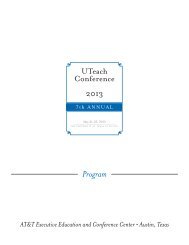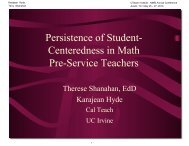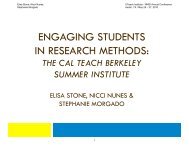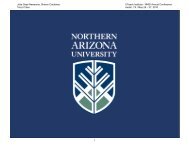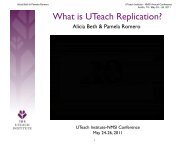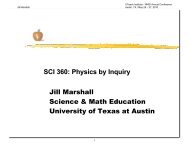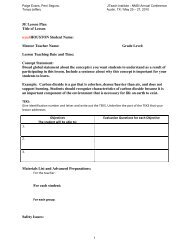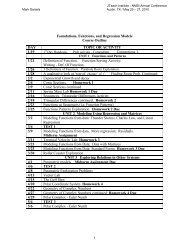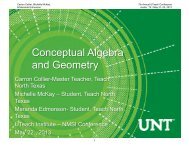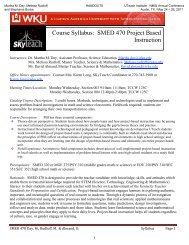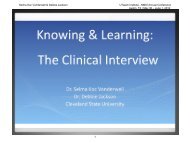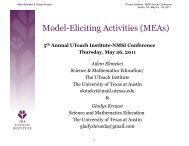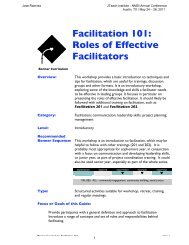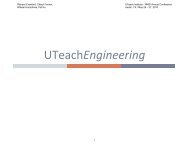Pinhole Camera Design Challenge Instructor Notes. Jill Marshall ...
Pinhole Camera Design Challenge Instructor Notes. Jill Marshall ...
Pinhole Camera Design Challenge Instructor Notes. Jill Marshall ...
Create successful ePaper yourself
Turn your PDF publications into a flip-book with our unique Google optimized e-Paper software.
<strong>Jill</strong> <strong>Marshall</strong> &<br />
Gretchen Edelmon<br />
Reading List<br />
Handout - 2<br />
<strong>Design</strong> <strong>Challenge</strong> Syllabus<br />
UTeach Institute - NMSI Annual Conference<br />
Austin, TX / May 24 – 26, 2011<br />
Anyon, J. (1980) Excerpt from “Social class and the hidden curriculum of work.” Downloaded from<br />
http://cuip.uchicago.edu/~cac/nlu/fnd510fall09/anyon.htm, 12/28/09<br />
Barnett, M. (2005). Engaging inner city students in learning through designing remote operated vehicles.<br />
Journal of Science Education and Technology, 14(1), 87-100.<br />
Ben-Zeev, T. et al. (2005). “Math is hard!” (Barbie, 1994). In A.M.Gallagher & J.C. Kaufman (Eds).<br />
Gender differences in mathematics. Cambridge: Cambridge University Press (p.189-206).<br />
Dong, Y.R. (2005). Getting at the content. Educational Leadership, 63(4), 14-19.<br />
Dong, Y.R. (2009). Linking to prior learning. Educational Leadership, 66(7) 26-31.<br />
Education Trust (2008). Their fare share. Downloaded 12/28/09 from<br />
www.edtrust.org/sites/edtrust.org/files/publications/files/TXTheirFairShare.pdf<br />
Johnson, D., Johnson, R., and Holubec, E. (1994). Chapter 3: Essential components of cooperative<br />
learning. In The New Circles of Learning: Cooperation in the Classroom and School (25-35).<br />
Alexandria, VA: ASCD<br />
Lawson, A.E. (2002). The learning cycle. In R.G. Fuller (Ed). A love of discovery: Science education, the<br />
second career of Robert Karplus. New York: Kluwer Academic(p.51-62).<br />
Ma, Liping (1999). Chapter 1: Subtraction with Regrouping. In Knowing and teaching elementary<br />
mathematics (pp.1- 27) Mahwah, NJ: Lawrence Erlbaum Associates.<br />
Manouchehri, A., & Lapp, D. (2003). Unveiling student understanding: The role of questioning in<br />
instruction. Mathematics Teacher, 96 (8), 562-566.<br />
Pierson, J. (2009). Responsiveness and intellectual work: Characteristics of teachers’ discourse that<br />
influence student learning, draft submitted to the 2009 Annual Meeting of the American Educational<br />
Research Association.<br />
Rothstein, R. (2004). Class and the classroom. American School Board Journal, 191(10), 17-21.<br />
Rowe, M.B. (1986). Wait time: Slowing down may be a way of speeding up! Journal of Teacher<br />
Education, 37(1), 43-50.<br />
You will also read additional articles describing research on student thinking and/or teacher<br />
strategies in the particular subject areas that you are assigned for Teach 1 and Teach 2 and on the<br />
topic you select for the equity poster session. A list of sample articles will be posted, but you are also<br />
welcome to identify articles on your own.<br />
EDC 365D Classroom Interactions, Spring 2010 Page 6<br />
6



